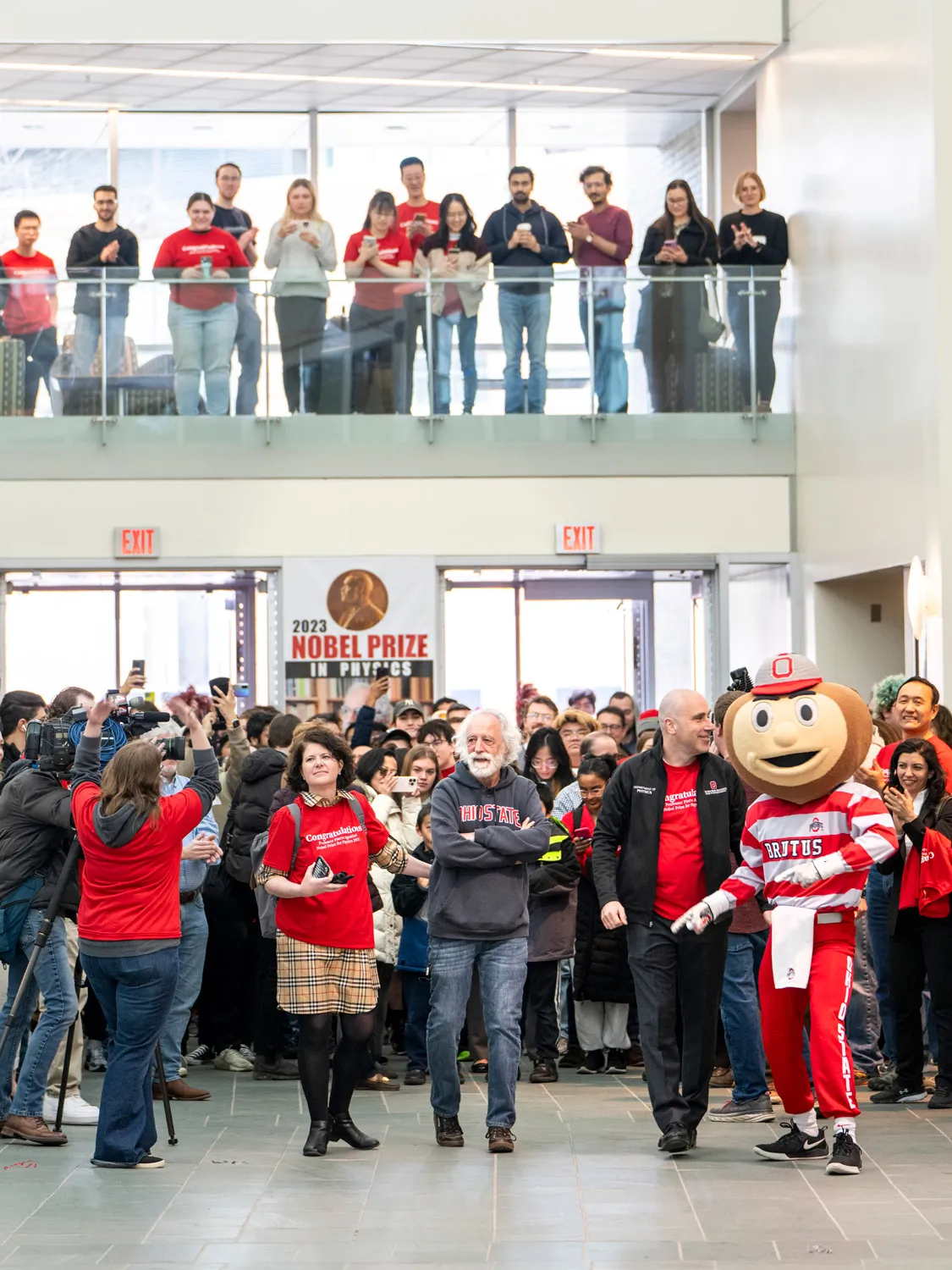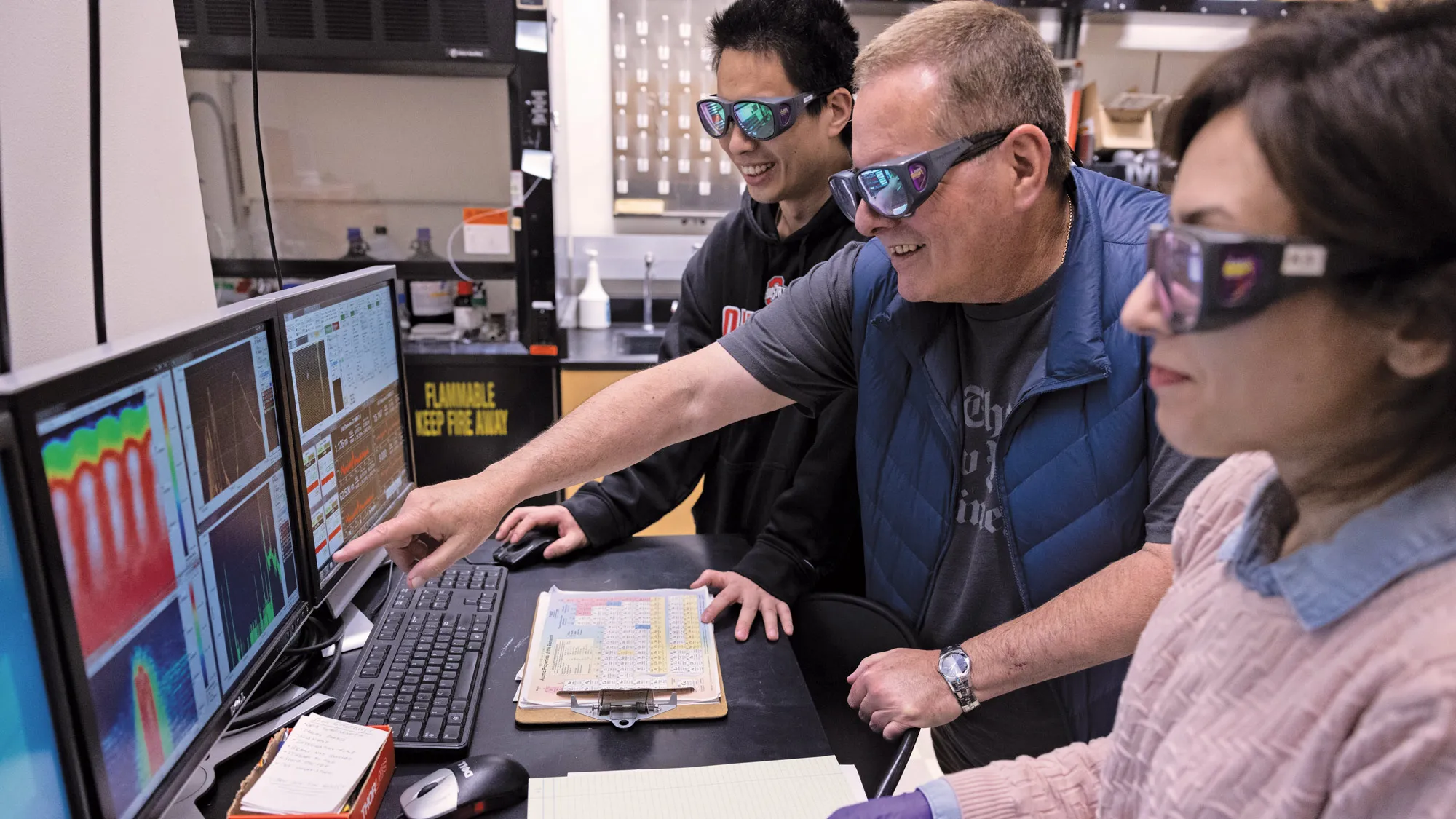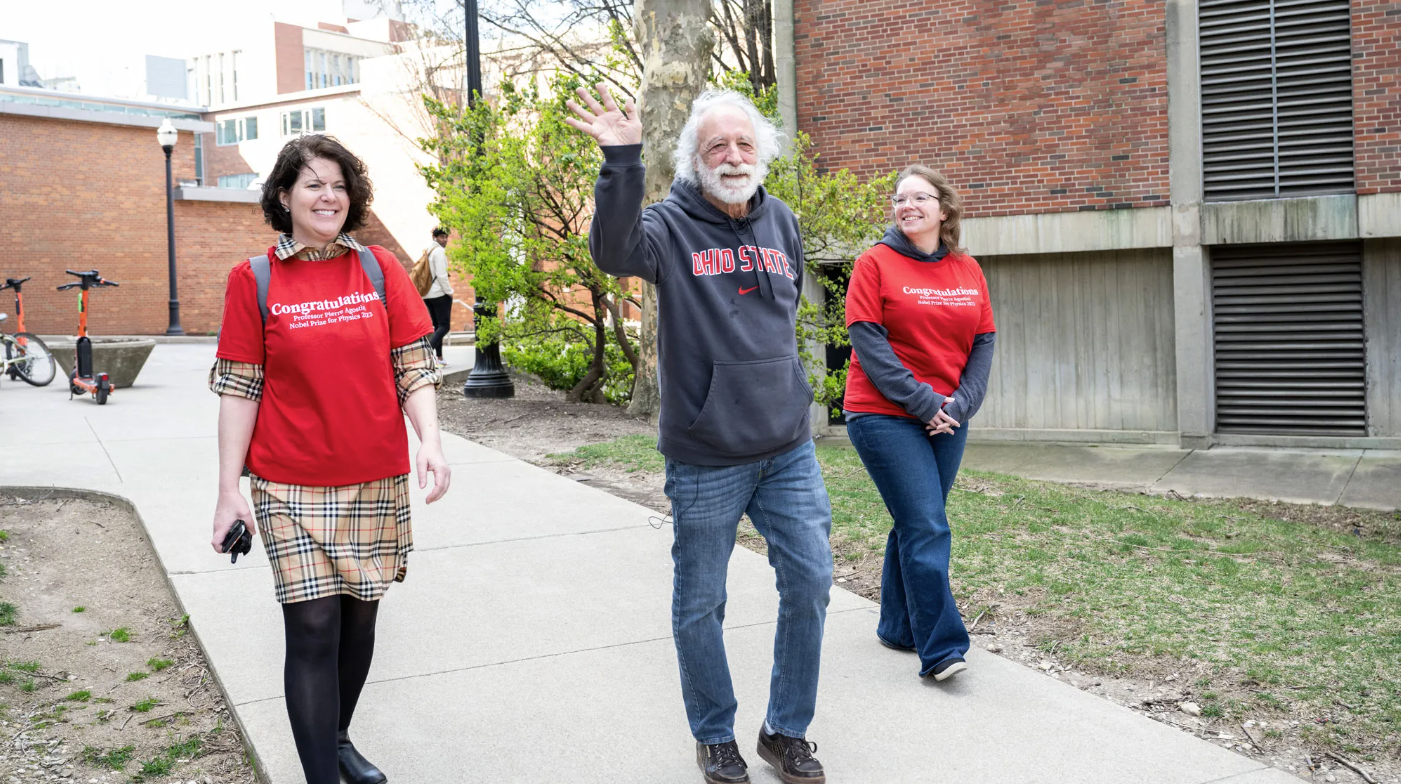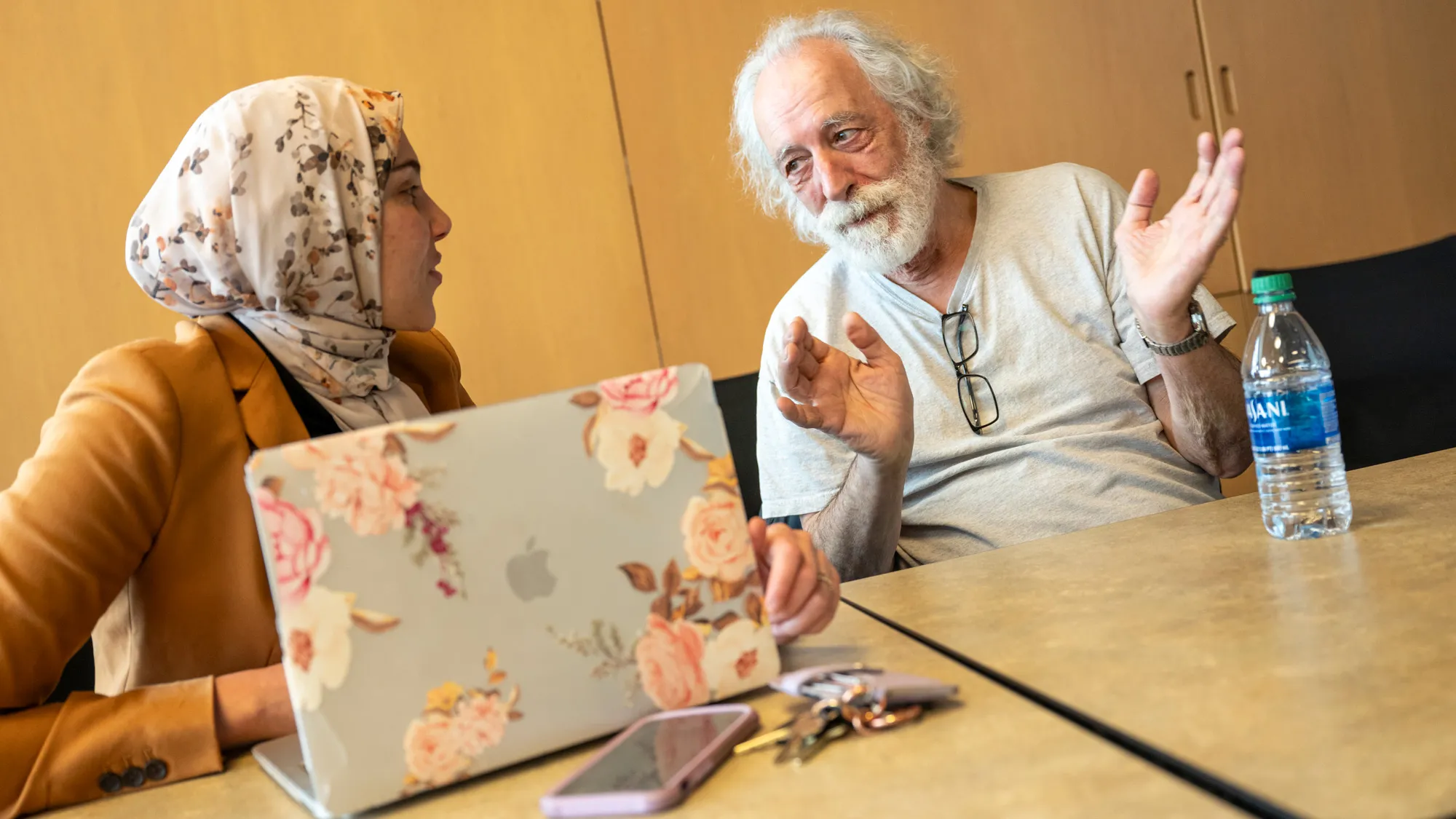The Long and Short of It
From original story in Ohio State Alumni Magazine by Kristen Schmidt
The long and short of it
Professors Lou DiMauro and Pierre Agostini, a 2023 Nobel Laureate, are developing the next generation of big thinkers.
At Ohio State, discoveries involving subatomic particles, using the shortest known increments of time, can take years. Yet the generations of students working in the Agostini-DiMauro Research Group take away important lessons every day.
Andrew Piper had grown so attuned to the apparatus dubbed the quantum trajectory selector, or QTS, that he could hear whether its constant drone was the right cacophony or not. He did not anticipate “basic plumbing” and “distinguish correct pitch of a functioning vacuum pump” would be accomplishments in pursuing a doctorate in physics at Ohio State, but he achieved them nonetheless.
Piper ’17 MS, ’22 PhD and Qiaoyi Liu ’19 MS, ’23 PhD, building on earlier students’ innovations, constructed the QTS and brought to life a decade-long research quest of Professor Lou DiMauro in his study of recollision physics.
DiMauro and a team of postdoctoral researchers and graduate students in Ohio State’s Agostini-DiMauro Research Group invented the design and fabricated the QTS apparatus. Their resulting paper, now pending publication, is the blueprint for this method and a record of what they observed when it started reporting extraordinary data, Liu says.
In simple terms, the field of recollision physics asks: What more can we learn about electrons when a laser bounces them out of their orbits and then they bounce back in? The QTS can answer that question, and now with attosecond precision.
The first QTS results were “almost overwhelming” to see, says Liu, now a postdoctoral fellow at JILA research institute in Boulder, Colorado. “It was a big moment for us.”
Liu immediately found DiMauro and texted his friends to share the news. He felt profound gratitude to be in the lab at that moment. Several “generations” of graduate students and postdocs had worked on this project at various stages — Piper had graduated only about a month before — and Liu recognized the work as collective and cumulative.

Dozens of people joined the clap-in to welcome Agostini back to campus in the spring and celebrate his Nobel win. Here they seek good vantage points to cheer for him inside the Physics Research Building. (Photo by Logan Wallace)
Pierre Agostini, a 2023 recipient of the Nobel Prize in Physics, and his longtime lab partner DiMauro could conduct research elsewhere. Agostini’s Nobel Prize aside, both physicists are decorated giants in their field. They chose Ohio State 20 years ago and, for many reasons, have continued to choose the university as the site for their work. Access to talent, space, equipment, funding, collaborations with other institutions and support are among them.
Crucially, Agostini and DiMauro share a deep commitment to shaping the next generation of scientists. Those who work in their lab say they are taken seriously from day one. Welcomed into an environment that is equal parts rigorous and inquisitive, students and postdocs see in these physicists the type of leaders they wish to become. The mentors come across as affable, self-deprecating, curious, kind. If they feel they’ve reached pinnacles, it doesn’t show in their pursuit of knowledge, though both are aware they are nearing the end of their careers.
Liu characterizes his professors’ ethos like this: “Regardless of stature and glory, just do good work and be critical of your work.”
The paths of DiMauro and Agostini first converged in the late 1980s and early ’90s, when DiMauro was a junior scientist at Brookhaven National Laboratory in New York and Agostini was an expert at CEA Paris-Saclay, a national research center of the French Alternative Energies and Atomic Energy Commission. Paris-Saclay had been Agostini’s professional home since he’d completed graduate studies, and it is where he conducted work that led to the Nobel Prize: In 2001, he and fellow researchers calibrated attoseconds by creating a train of pulses, each 250 attoseconds in duration.
DiMauro and Agostini collaborated in strong-field laser science — the study of how high-power lasers interact with solids and gases — throughout the ’90s. When DiMauro was recruited to Ohio State in 2004, he all but made it a condition of his acceptance that Agostini be asked to join the faculty, too.
Agostini came to Columbus in 2005 and reached emeritus status in 2018. They became friends, sharing taste in music and Marx Brothers films. “There’s a kinship and friendship that develops that releases barriers. We can toss around crazy ideas. We’re not trying to impress each other,” DiMauro says. Asked during an April colloquium at Ohio State to name some of the most meaningful moments in his career, Agostini paused and then replied, “Maybe the time I met Lou DiMauro.”
DiMauro found the experience of re-establishing his lab in Columbus refreshing and exciting. The Department of Energy wanted to continue to fund his work, and he was now open to apply for other funding. “The fact that I came to Ohio State allowed me to expand the group. These ideas were all in my head when I was at Brookhaven, but I didn’t have enough manpower to carry them out,” he says.
Today, the Agostini-DiMauro group is funded by the DOE, the National Science Foundation, the scientific arm of the U.S. Air Force and other sources. Diverse organizations have an interest in this research — for sheer scientific discovery, national security and technological implications. Where DiMauro worked with a few graduate students and a postdoctoral fellow at Brookhaven, the lab at Ohio State quickly expanded to fund 15 grad students and postdocs. This is an unusually large lab with ample longevity and continuity — the type of structure needed to pry open discoveries in atomic physics.
As research assistants gain seniority and experience, they work more closely with DiMauro and Agostini, gradually becoming colleagues able to hold their own in complex conversations and debates, challenging the faculty members, devising experiments and becoming co-authors.
“I like to give them their own space to develop,” says DiMauro, Ohio State’s Dr. Edward E. and Sylvia Hagenlocker Chair in Physics. “I want them to be the master of the experiment, not me.”
Alumni who have thrived in this collaborative environment say they are propelled by the inquisitive, open culture Agostini and DiMauro encourage.
“They put the work first, and there’s always more to be improved. They’re not complacent,” Liu says. “We could discuss the usage of a word for hours on end. The specificity, the technicality really rubs off on you. Their passion rubbed off on me, seeing the attitude and, for some folks, obsession. These people care.”
Piper found that to be the case, too, and admired how his professors engaged, followed through and sparked curiosity. After graduating, he took a job with IonQ, a quantum computing company in College Park, Maryland.

In their lab, DiMauro, research scientist Yaguo Tang, left, and postdoctoral researcher Tahereh Alavi review “photos” of their electron work. (Photo by Jodi Miller)
“The thing that keeps me interested in physics is that excitement of discovery and satisfaction of making the machine work. People think physicists are antisocial. Most people don’t like to talk the way we talk to each other. They think we’re combative. We’ll stand at the white board and ask, ‘Is that really true? Is that a fair assumption?’ We are trained to talk that way. We have this desire to achieve ground truth.”
This practice serves him well in his current work. “I like sitting with a group of other physicists, engineers and scientists trying to solve the problem of whatever malfunction we’re pushing through today.”
As an undergraduate, Liu was awarded a coveted internship at Fermilab National Accelerator Laboratory near Chicago. He came to Ohio State believing he wanted to steer toward high-energy physics, but after a year of exploration as a grad student, he was drawn to quantum mechanics through optics — what DiMauro and Agostini do. Liu is attracted to fundamentals and finds plenty to explore there. His focus at JILA is in physics education research, developing better undergraduate lab courses so students like his younger self will continue to enter the field and forge ever-newer discoveries.

Agostini and two of his key university supports, Dawn Larzelere, left, and Jessi Middleton ’11, arrive at the clap-in to celebrate his Nobel. (Photo by Logan Wallace)
An attosecond, for the uninitiated, is an extremely small slice of time. So small that there are as many attoseconds in one second as there have been seconds since the birth of the universe. In this unfathomably short timeframe, much is happening in the equally unfathomable subatomic arena. The “attosecond pulse train” witnessed by Liu in the quantum trajectory selector was a calibrated series of attosecond pulses. That he could use those at all was thanks largely to Agostini.
Agostini shared the 2023 Nobel Prize in Physics with Anne L’Huillier, whose tenure at CEA Paris-Saclay overlapped his, and Hungarian physicist Ferenc Krausz. The scientists were recognized for contributions to the discovery, measurement and observation of attoseconds.
“What can we do with a train?” Agostini asked the colloquium audience. Isolating a single pulse — attributed to Krausz — was an achievement in and of itself. A calibrated train of pulses is useful in experimentation, and this is Agostini’s Nobel-recognized impact on the field.
As astrophysicist Matt O’Dowd explained on “PBS Space Time,” Agostini shot a laser beam into an apparatus, where it was split in two. One, directed through a cloud of gas, became frequency-multiplied, and the other bounced around a series of mirrors before rejoining the first near the end of the apparatus. This experiment created a measurable attosecond train consistent in time and wavelength.

“I was proud to represent Ohio State’s scientific community in Stockholm,” Agostini said in sharing a Nobel medal replica with Physics Chair Michael Poirier. (Photo by Logan Wallace)
The experimental action in attophysics occurs between those pulses. One of the experimental fields is recollision physics — the purpose of DiMauro’s quantum trajectory selector.
Scientists working in the fields of atomic physics and optics keep discovering new ways to slice time into ever-finer slivers in service to the exploration of electron behavior. In his Nobel lecture, delivered in December 2023, Agostini said this progress will come to a necessary end. “Is time infinitely divisible? From a physics point of view that’s doubtful because it takes more and more energy to produce those short pulses,” Agostini says. “We are still very far from that time, but you cannot divide time infinitely.”
Not even physicists see or feel the phenomena they study — they experience them only through data captures and visualizations. Hence, DiMauro says imagination has served him incredibly well throughout his life.
“I always thought about problems that I kind of think are going to take at least 10 years or more to solve. If you’re closing shop in, say, two years, I have to throw those things out of my mind, which is throwing out the imagination part,” says DiMauro, 71, who is starting to consider retirement. “It’s been a very important part of how I and people like Pierre work. The imagination is something that never leaves your head.
“I believe that a very successful scientist has two, maybe three good ideas in their career. I can point to myself and mark where those good ideas were. The ideas launched 10 or 12 years of my group working on it and the rest of the world working on it. Pierre is the extreme example with the vision of the attosecond.”
Invariably, the question of “so what” arises when discussing these endeavors. Why use lasers and light frequencies to experiment with particles? Why chase the division of time into finer and finer increments? Pure experimentalists such as DiMauro and Agostini do not think about eventual applications of their work.
“I don’t feel any pressure about how I may be contributing to society,” DiMauro says. “The first thing is just education and training and putting a workforce out there. I think we’ve done that very well. I was counting one day how many people went through my group … the number’s like 75 or 80 people, and the vast majority are employed doing something technical. When our students graduate, whatever career path they choose, they’re well prepared and marketable coming out of our group.”
Piper demonstrates this when he explains that, to construct the quantum trajectory selector, he and his fellow students needed to engineer structural solutions, manage budgets, work with vendors, source materials, schedule and coordinate with other people. “A lot of that carries over to what I’m doing now. You’ve got all these physical problems you have to manage, and it takes many people of many skill sets to keep the team going,” he says.


